We know how important it is that your everyday emails look just as good as your one-off sales emails. That's why we've added three brand new transactional Design Ideas to the app which you can edit and start using right away!
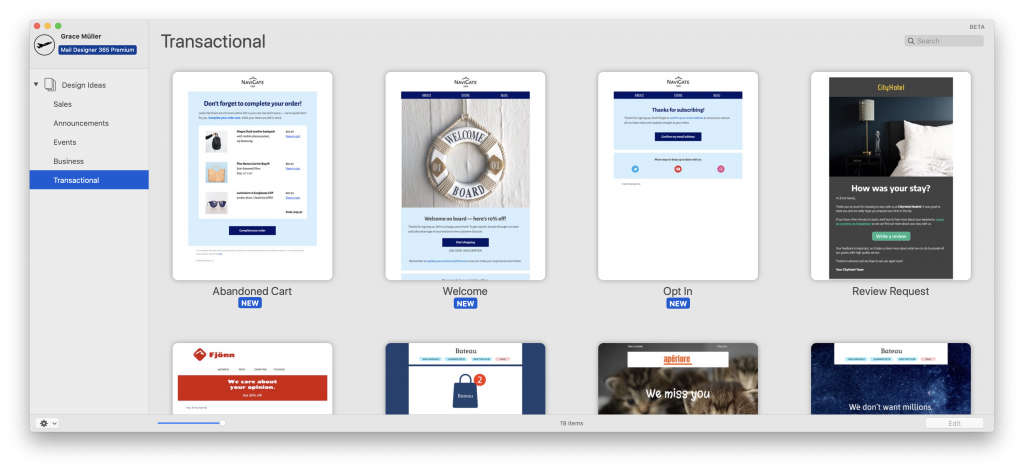
We know how important it is that your everyday emails look just as good as your one-off sales emails. That's why we've added three brand new transactional Design Ideas to the app which you can edit and start using right away!

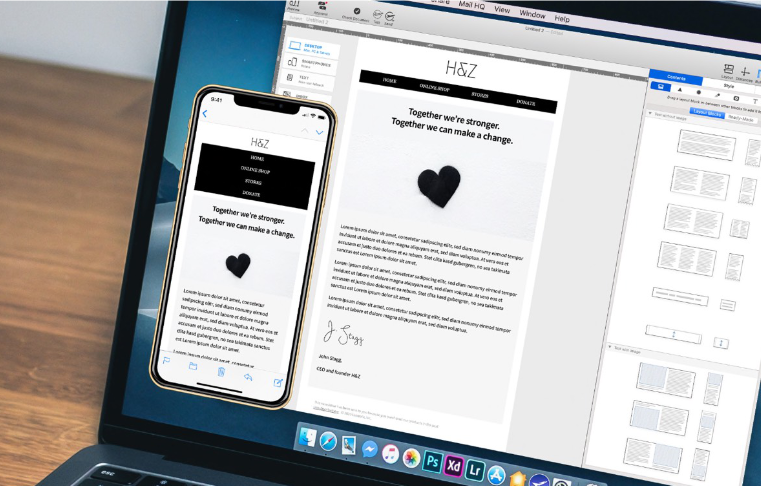
Whether you're informing customers about an upcoming product launch, sharing a statement, or communicating important changes to subscribers, being able to write effective announcement emails is a key skill needed by businesses of all sizes.
In this article, "announcement email" is very much an umbrella term for your core communication with customers (outside of standard sales emails.) An announcement email can take many forms, including but not limited to:
Also important to consider: Oftentimes, announcement emails are much more text-heavy than a standard marketing-style email, as the sender usually has a lot to say.
As a business owner, email is the most reliable way to make important announcements to your subscribers. Although social media is booming, complicated algorithms often mean many of your subscribers on platforms like Instagram, Facebook and Twitter don't even see your posts - resulting in important information going unread.
Email is a direct channel between you and your customers with very little background noise to take away from your key message. For this reason, when done correctly, an announcement email has the potential to lock in high open rates and get better conversions.
Here are some useful tips to consider when sending an announcement email, plus some great examples of announcement emails we have collected from around the web and our own personal inbox.
One way of ensuring your announcement email is a success is through great communication. This can be achieved by producing strong and convincing email copy to really make your message clear to readers.
Think carefully about the context of your announcement. This will help you determine the tone you want to use and will help you choose your words more carefully.
For example, if your email announcement is of a serious nature, it is probably more fitting to opt for a formal and professional tone. For an exciting announcement like a product launch or a new store opening, you can afford to have a little fun with your email copy and adopt a more relaxed tone.
Other important aspects that will help elevate your email copy include:
In this email statement, CreativeMornings use powerful, well-thought-out prose and a clear layout to show their solidarity with the #BlackLivesMatter movement.
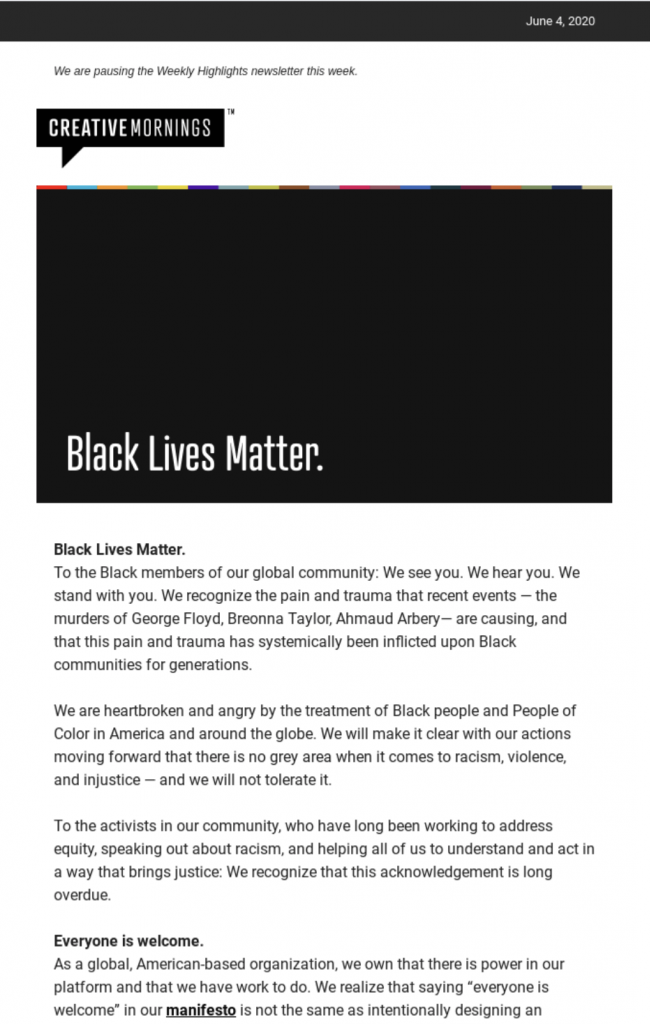
CreativeMornings show their support for the #BlackLivesMatter movement through powerful prose.
The way your email looks is - in many ways - just as important as what it says. An eye-catching header graphic or a strong feature image can be all it takes for your reader to pay more attention to your email.
Take this announcement email from Avanti West Coast - Although the rest of the email is quite plain, Avanti do a great job of drawing in readers using a colorful and abstract header design. The simple title "Important information" is enough to let the reader know this is something they should be paying attention to:
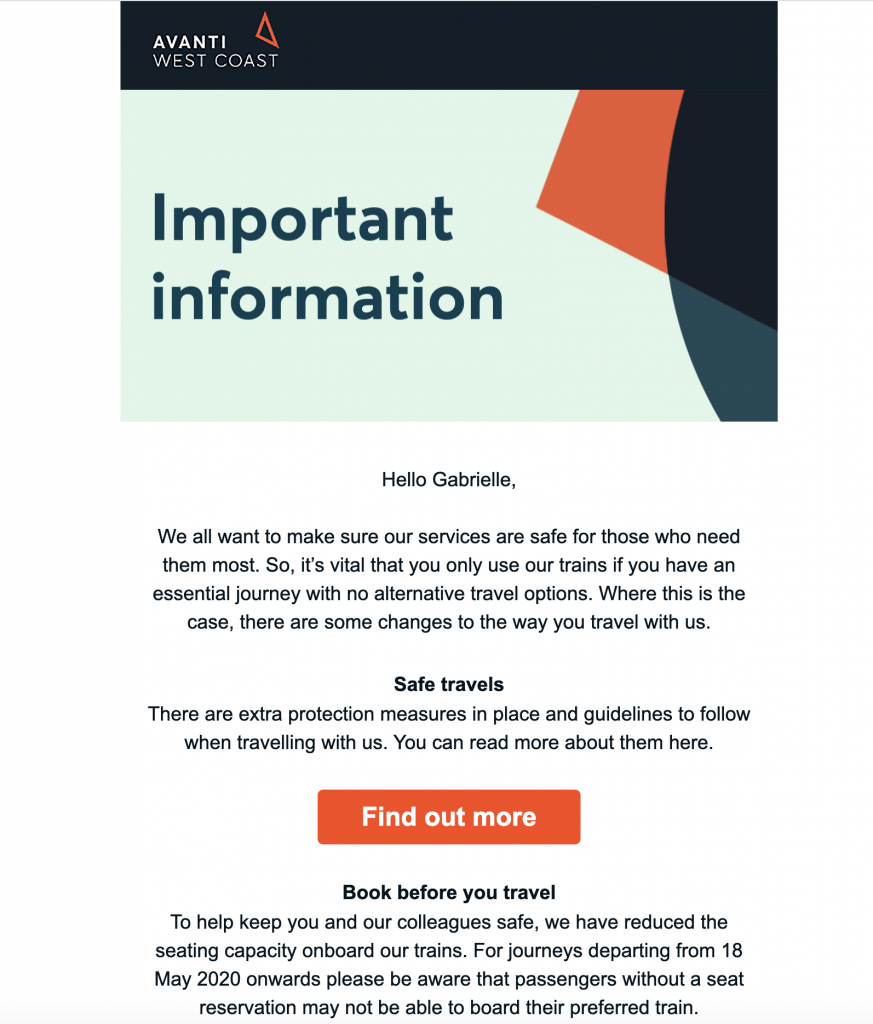
A great header design helps this announcement email by Avanti capture readers' attention.
Tip: You can create a similar header effect in Mail Designer 365 by layering shapes and adjusting the opacity:
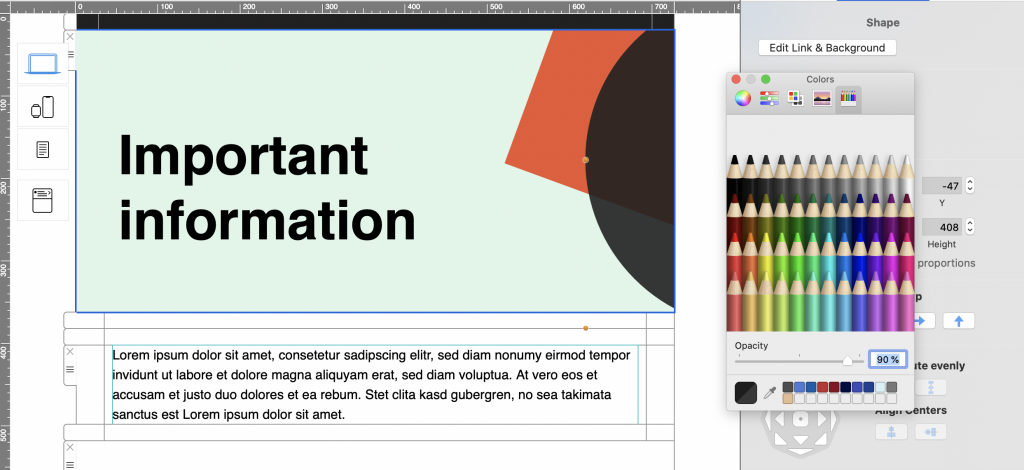
Another style element which is important to your design's overall effect is your font choice.
While it's tempting to get creative when it comes to fonts, oftentimes, simple is best. Especially when your message is so important, you don't want to run the risk of a poor font choice getting in the way of clear communication.
Choose a clean, easy-to-read font in a sensible weight to apply to your email copy. You should also avoid overusing bold or italic, as this appears confusing to readers. When you're done, remember to configure an email-safe "fallback" font to ensure your email text is displayed properly in all clients:
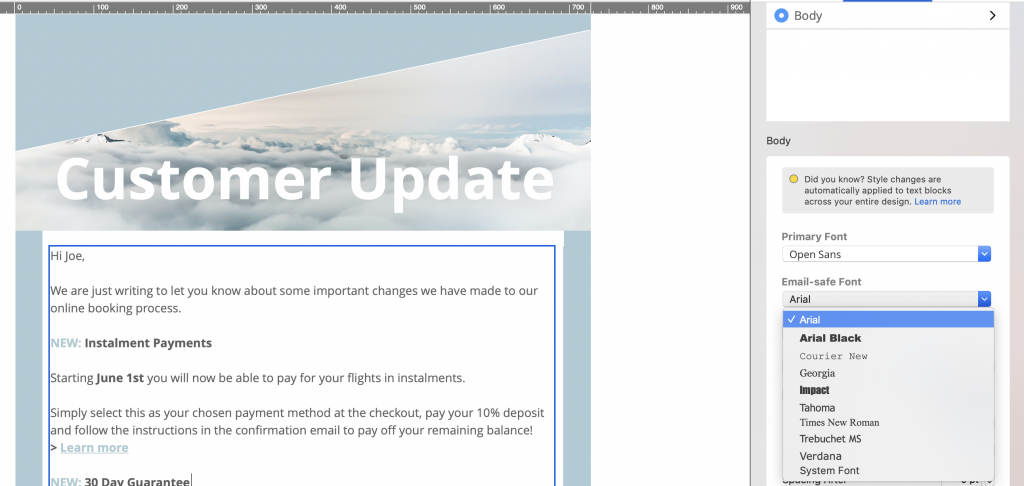
Always include an email safe fallback font to ensure better compatibility with other email clients
Any marketing email needs to be able to demonstrate a clear call-to-action. Whether you want your readers to sign up for an event, pre-order a new product, or simply visit a landing page, you need to point them in the right direction first.
Use a CTA (call-to-action) button which clearly stands out against the rest of your email in order to make it prominent to readers. You should also make sure the text of your button is short and snappy and check that the link leads to a sensible destination.
By choosing a vibrant shade of red for the CTA in this tour announcement email, Live Nation are able to convey a sense of urgency and encourage readers to sign up for event access:
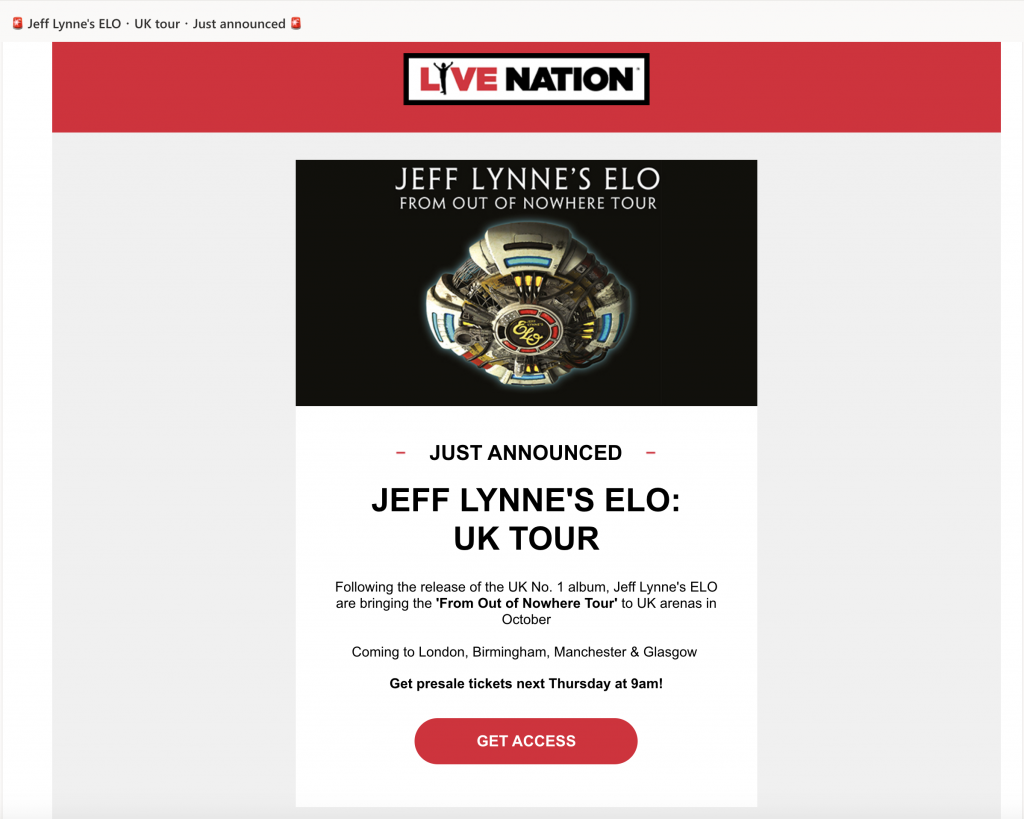
The bold, red CTA button in this tour announcement email by Live Nation jumps out at readers.
Experiment with shapes and font styles in Mail Designer 365 to create dazzling CTA buttons for your own email designs:
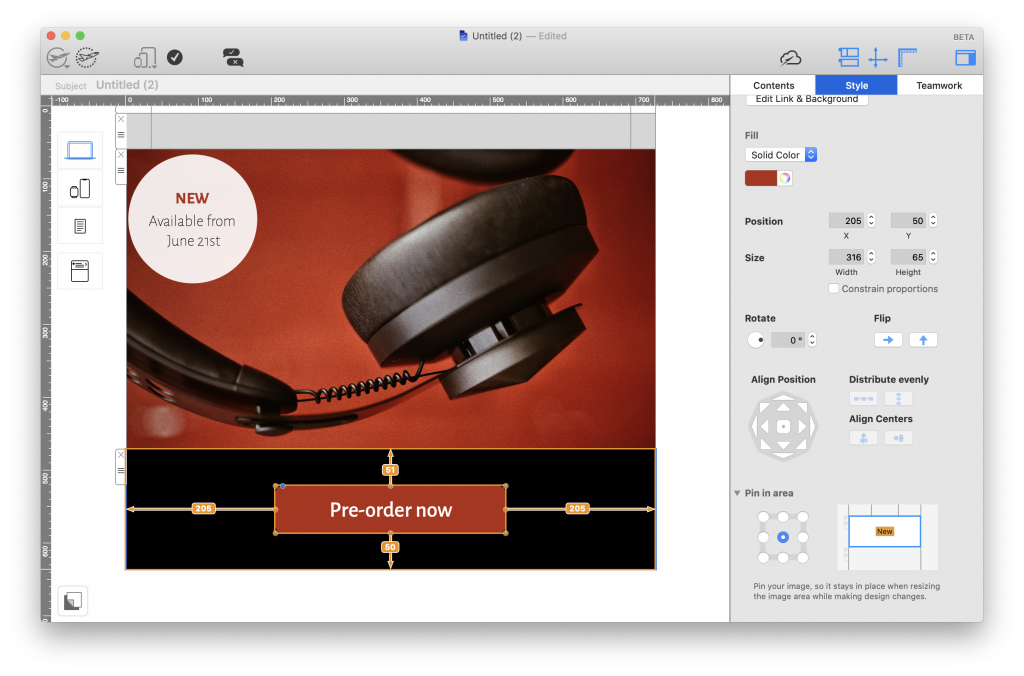
Mail Designer 365 has all the shapes and text styles you need to create bold and effective call to action buttons.
Your email's subject line is the very first thing that recipients will see and is often the determining factor in whether or not your email gets opened. For this reason, you need to ensure your subject line is interesting and intriguing enough to pique your customers' interest.
When you are coming up with a subject line, be sure to include key words such as "new", "announcement", "exciting news", etc., in order to let your readers know what the email is about. By teasing your new product, upcoming event, important news, etc., you are bound to make your readers curious and encourage them to open up your email.
Furthermore, using emojis in your email subject is another great way to ensure it will stand out in their inbox.
Because so many people today now check their emails on the go, it's crucial that your announcement email has also been optimized for mobile devices. This is a key part in ensuring that your message is effectively communicated.
Mobile optimization includes aspects such as:
Mail Designer 365 automatically creates a mobile responsive version of your email design, which you can optimize and edit separately to your main desktop design. Simply navigate to the Smartphone view and detach a layout block to begin creating mobile-only content:
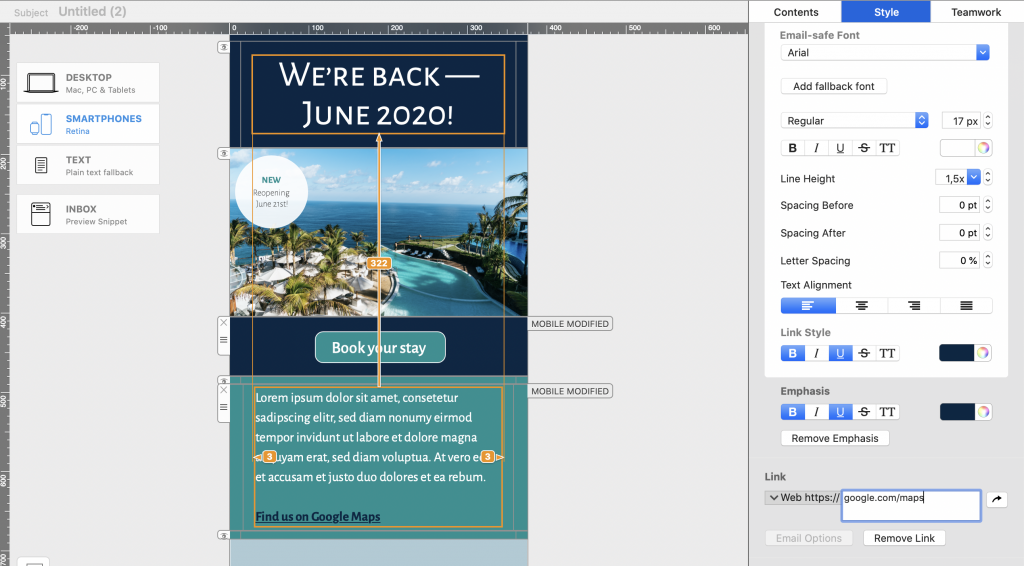
Use the Mail Designer 365 smartphone editor to create mobile optimized announcement emails.
The final way of ensuring your announcement email is a success is by making sure you send it to the right target audience. Sending one email to your entire list is usually a bad idea and is generally only reserved for exceptional circumstances (i.e. major business announcements.)
When you are setting up your campaign in your email marketing platform, think about who will find this information most relevant. This group should be your first priority, as they are more likely to engage with your email. If you can think of other groups who may also find the email beneficial, you can go back to adjust and optimize your template accordingly.
Looking for tips? Here are some useful segmentation techniques you could try out:
Email List Segmentation Techniques to Learn More About Your Subscribers
If you are in need of some inspiration, here are a few more announcement emails which we found particularly effective...
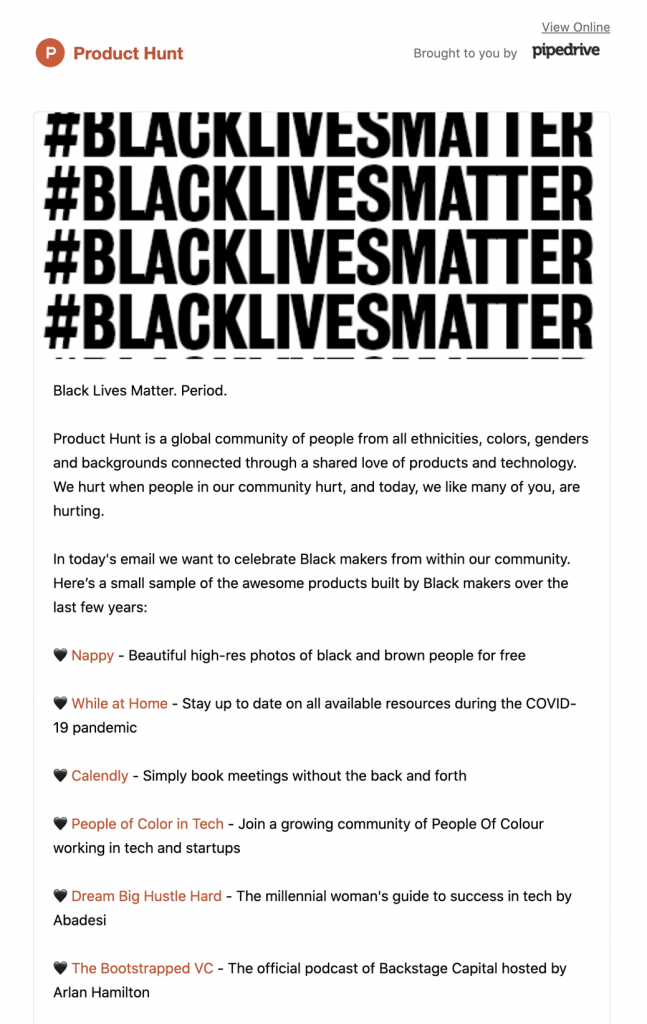
The striking header graphic in this email by Product Hunt gets their important message heard loud and clear.
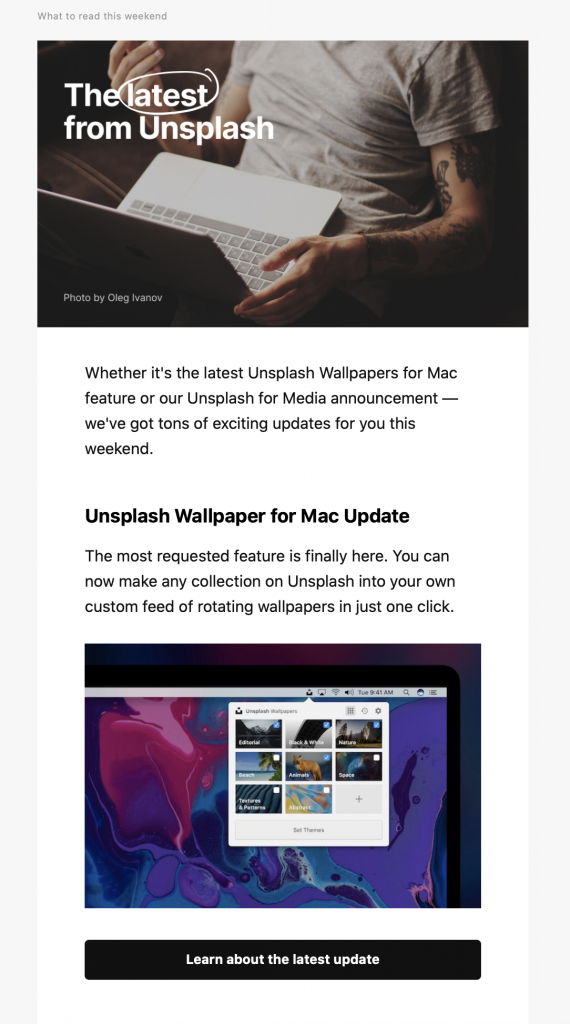
This simple newsletter-style announcement email by Unsplash is both informative and interesting for users of the service.
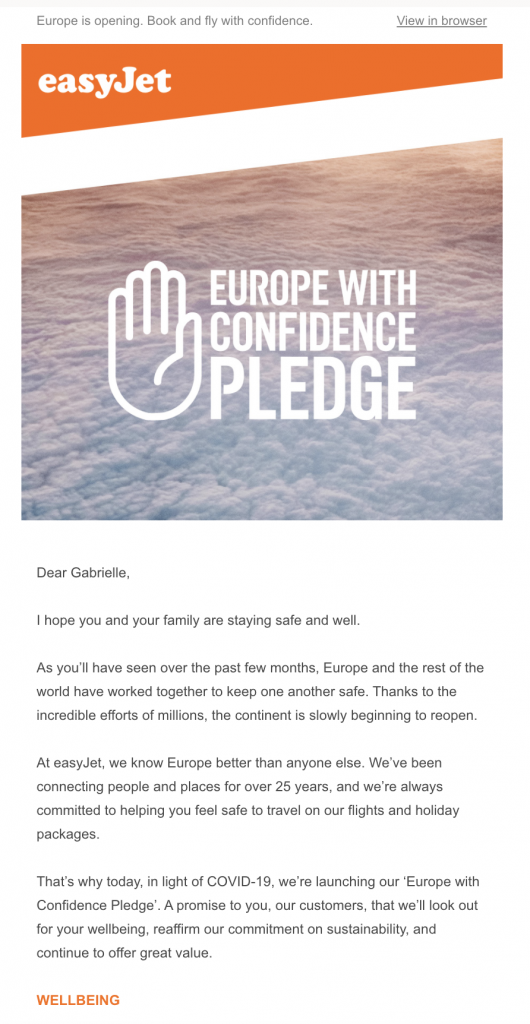
easyJet use the header of this announcement email to grab readers' attention before sharing their important update.
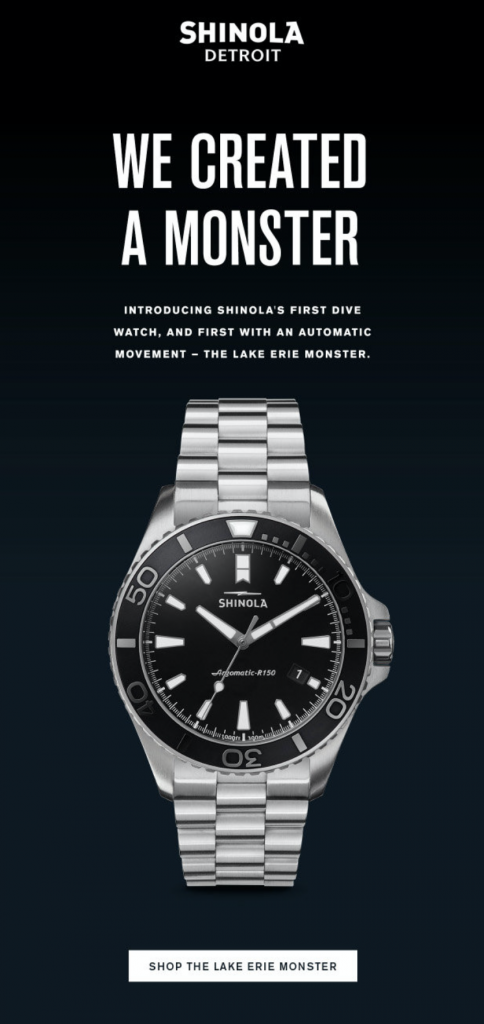
Shinola use bold design techniques to win customers' attention in this new product announcement email.
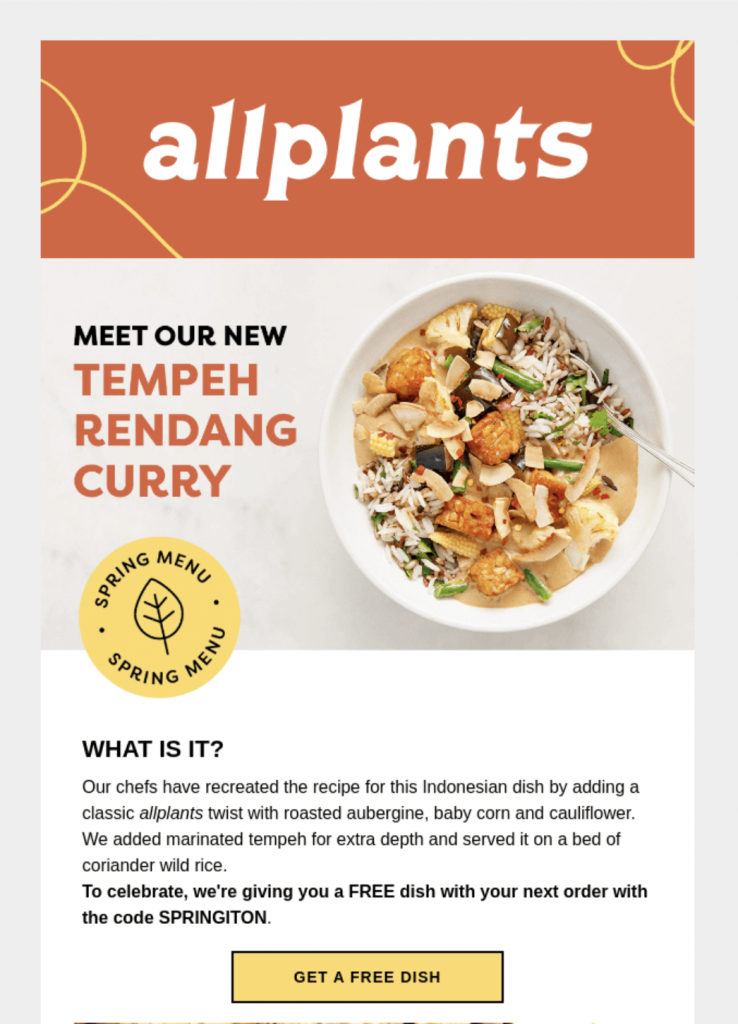
allplants do a great job of using a colorful CTA button together with a clear layout to introduce a new dish to their menu.
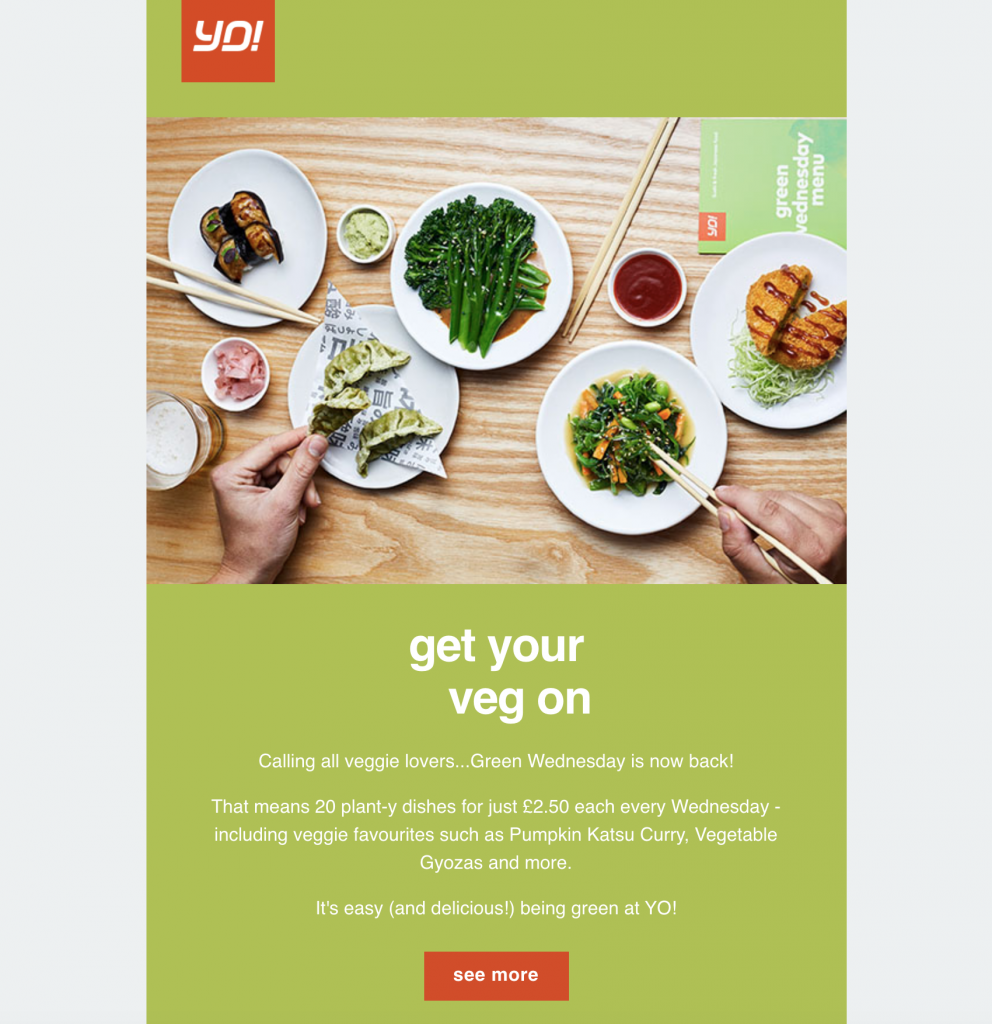
YO!Sushi also mix contrasting color combinations with a big feature image to get customers excited about the return of their "Green Wednesday" promotion.
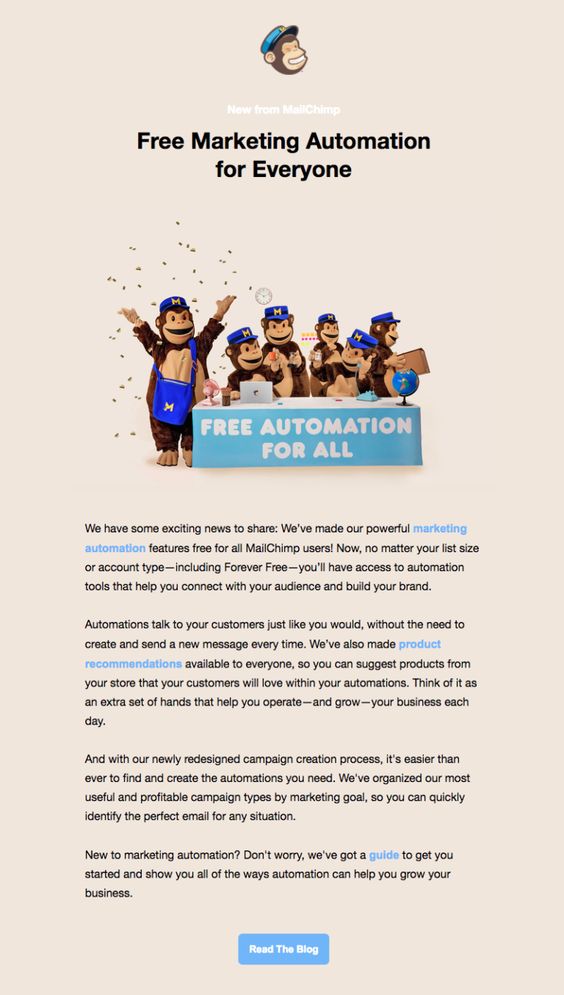
This announcement email by Mailchimp concentrates a lot on great email copy and an effective CTA button.
We hope you are feeling inspired and will take these tips on board the next time you ned to make an important announcement for your business.
Mail Designer 365 has all the tools and email template options you need in order to create a fabulous announcement email and share your great news with your subscribers. Sign up today for free to get started!

There's no denying that online events are massively on the rise. If you take a glance at the average business calendar today, you'll likely see event titles that didn't even exist 10 years ago. (Ever heard of a virtual trade fair? I hadn't until researching for this post!)
Of course, as the way we hold events changes, so does the way we market them. In this guide, we talk about some great online event ideas for your business, plus the best tools to help you ensure your event is a success.
Jump to:
Quite simply put, the main advantage of a virtual event is flexibility. The majority of the time, all your guests need to get involved is a working internet connection - which is definitely not hard to come by these days!
Because online events are so flexible, people can take part from wherever they are - whether it's from the comfort of their own homes, or from their office 5000 miles away from the actual location. This flexibility means your event can reach a much wider audience of new potential leads.
More advantages of hosting an online event include:
A video meeting does exactly what the name describes. These types of meetings can take place on any scale and for any use case: no matter how big or small. Here are a few popular examples:
For many, an offsite meeting means travel costs, food & drink and possibly an overnight stay all being charged to company expenses. Not to mention the time taken to get there and back is time which could have been spent doing other important work. Holding a video meeting means all participants can join from their respective locations and save the company time and money.
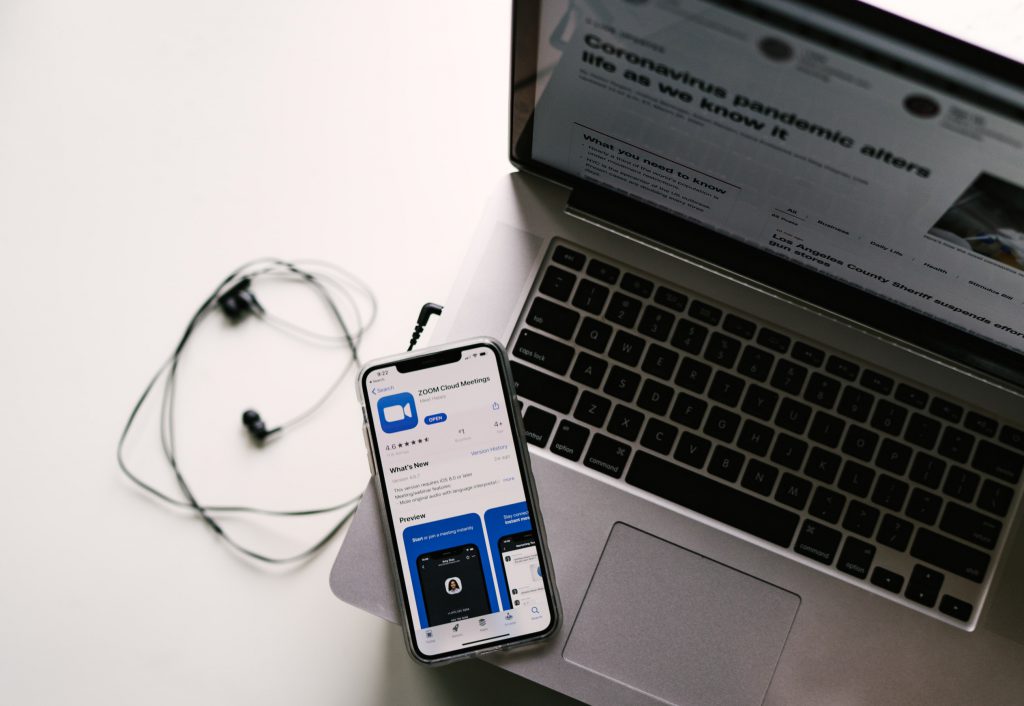 Video meetings are also a game changer for remote-based teams to stay connected. All you need to get started is a working internet connection, a headset and a video meeting platform to host from.
Video meetings are also a game changer for remote-based teams to stay connected. All you need to get started is a working internet connection, a headset and a video meeting platform to host from.
A webinar is an online seminar most typically used to educate viewers on a particular topic. This could be anything from a step-by-step product demonstration (particularly popular with software companies) to a university-style lecture on a given theme (e.g. How to create a website for your small business.)
Most often, a webinar is a mixture of pre-recorded screen sharing with voiceover commentary; however, the webinar host(s) can also choose to livestream the event in order to allow for interactive elements such as a Q&A session or a quiz. Usually, a webinar won't last longer than an hour.

Pro tip: When you send out your invitations, make sure you outline exactly what will be covered in the webinar so people will be more willing to sign up. For more great tips on how to market your webinar, check out this guide.
This type of online event involves you sourcing established guest speakers from your field to come together and collaborate. Participants tend to discuss a chosen topic (i.e. education or technology), or provide solutions for well known industry problems (e.g. how to increase student participation in your classroom.)
Guest speakers will generally prepare material to present and, if held live, offer the audience the chance for a Q&A session.

While this type of event is usually less specific to your business, it is a great opportunity for lead generation. Each guest speaker brings a virtual audience with them; all of which become potential leads for your business.
An event like this is also a great way to establish your authority in your industry and gain key contacts.
Pro tip: To ensure things run smoothly, start planning the dynamics of your virtual summit quite far in advance. It can also be beneficial for guest speakers to pre-record their content to make the event appear more seamless on the day.
An online course is a type of online learning environment which can be set up to deliver lessons or follow-along courses on a particular subject. An online course can consist of a series of sessions (i.e. for distance learning or online qualifications) or it can be a one-off event.
If held live, online training events are generally best suited to smaller groups, in order to recreate the classroom experience and allow for participants to ask questions. While there is still an element of presentation, an online course is intended to be a much more interactive experience for those involved.

Pro tip: After streaming a live lesson, it's a good idea to upload your video to a portal where participants can then watch it back at a later date.
Similar to a physical trade fair, a virtual tradeshow is a type of online marketing event which is held to give participants the chance to present their products to potential buyers.
Most typically, each vendor will have a dedicated "booth" in which they can present prepared material including webinars, tutorials and product introductions. Many virtual tradeshows also have e-commerce integration so attendees can purchase directly.
Although the virtual tradeshow may be the biggest change to the real thing, it is a great strategy for companies who want to cut down on costs, or businesses looking to try innovative new methods to reach new customers.
With online events on the rise, more and more awesome tools are becoming available to help businesses guarantee their events are a success. Below, we have highlighted some of the current leading tools for managing and hosting online events. Skim through the list to see the key features and click through to the operator website to find out more!
Zoom is currently one of the most popular choices for online meetings.
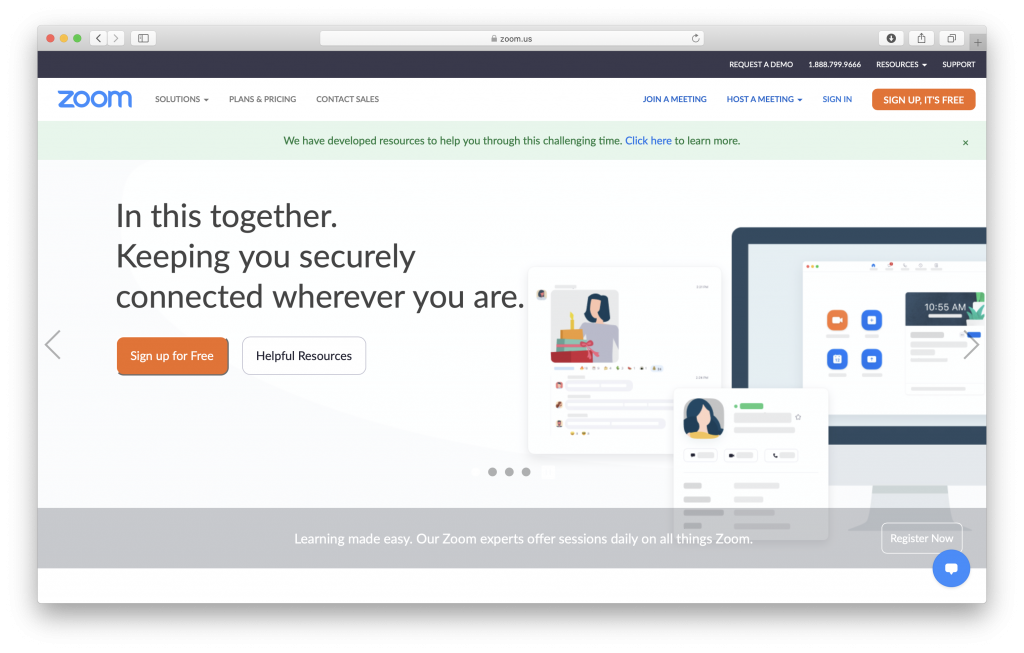
Google Meet is a brand new video conferencing platform by Google which replaces their Hangouts Meet platform.
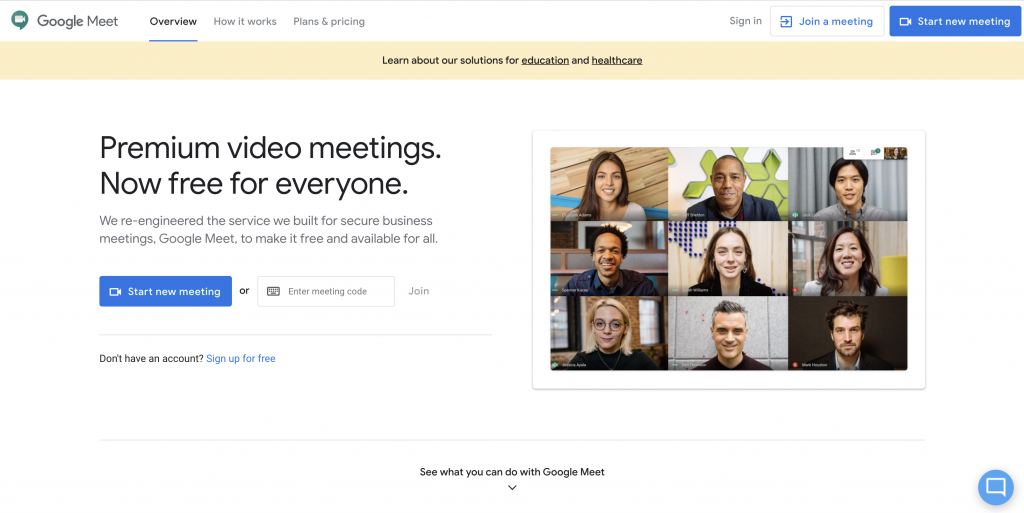
Adobe Connect is a standalone, advanced web conferencing software.
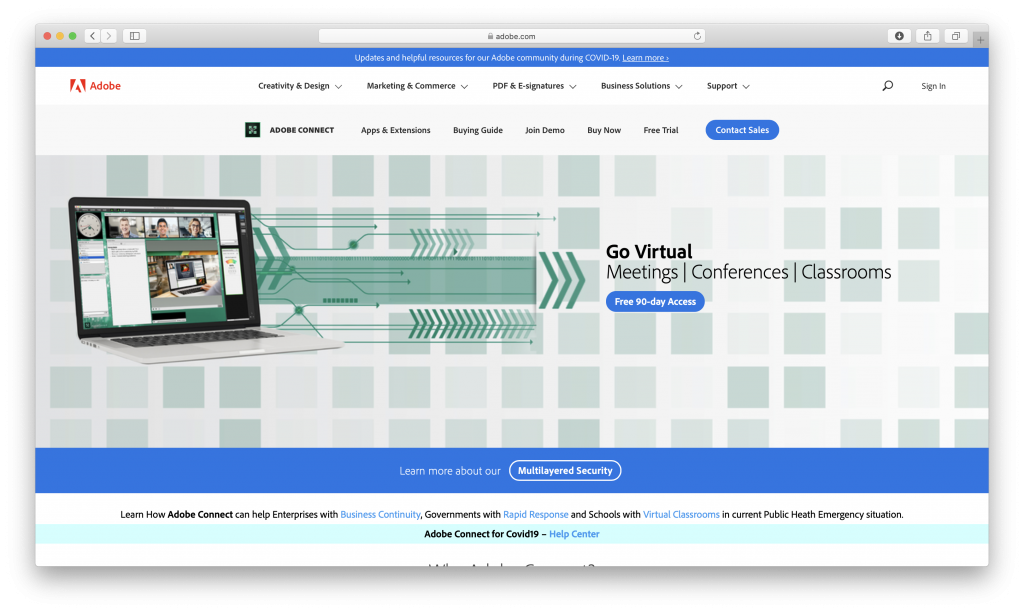
Cvent is an event management platform for larger online events.
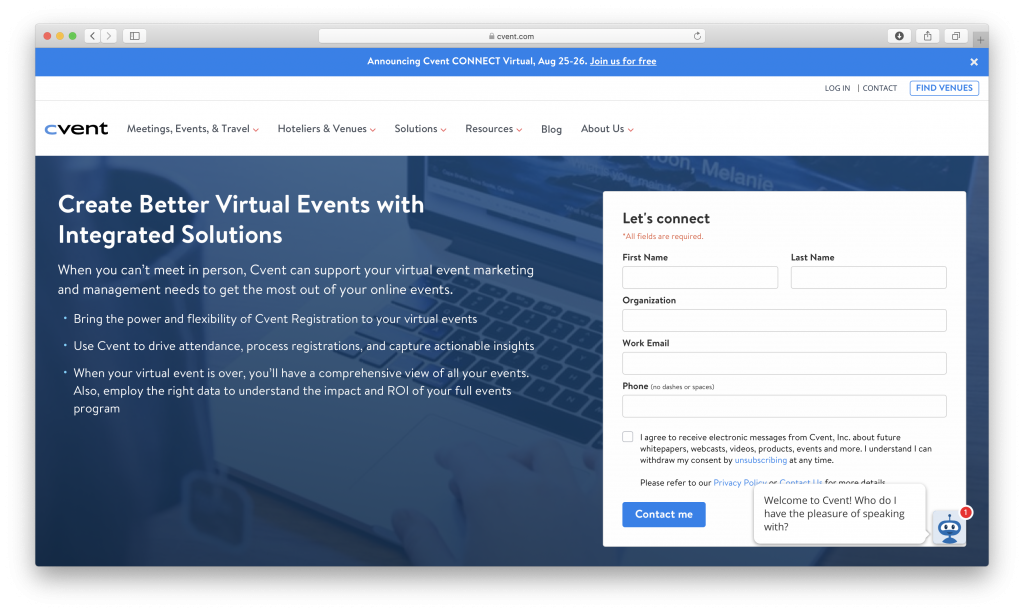
GoToMeeting is a video meeting tool with dedicated add-ons for conferences and webinars.

vFairs is a virtual events platform that allows users to plan and structure tailor made online events.
The build up to your online event is just as important as the event itself. During this time, you need to successfully promote your event among your target audience and ensure you have as many sign ups as possible.
The best way to generate attention around your online event is with email marketing. A solid email strategy helps you sell your event to invitees and allows you to follow up with potential leads once the event is over.
Mail Designer 365 has all the creative tools you need to build impressive an email invitation for your online event, as well as reminder emails and follow up campaigns. Check out this post to find out more about email strategy for online events.
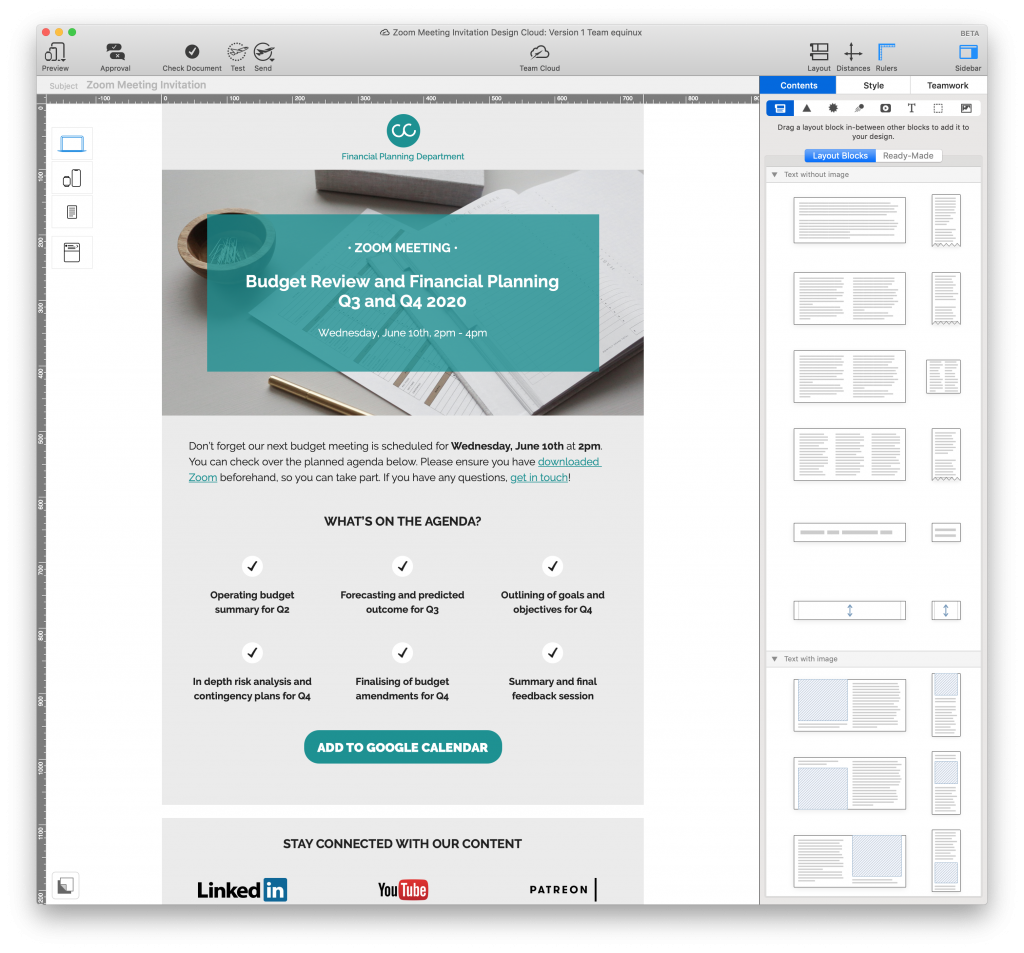
Use this Mail Designer 365 email template to announce a webinar, Zoom meeting, conference, or any other online business event.
Until next time,
Your Mail Designer 365 Team
Get more inspirational tips, tricks, and best practice examples in the Mail Designer 365 Newsletter Academy -
your one stop hub for all things email marketing strategy and newsletter design.
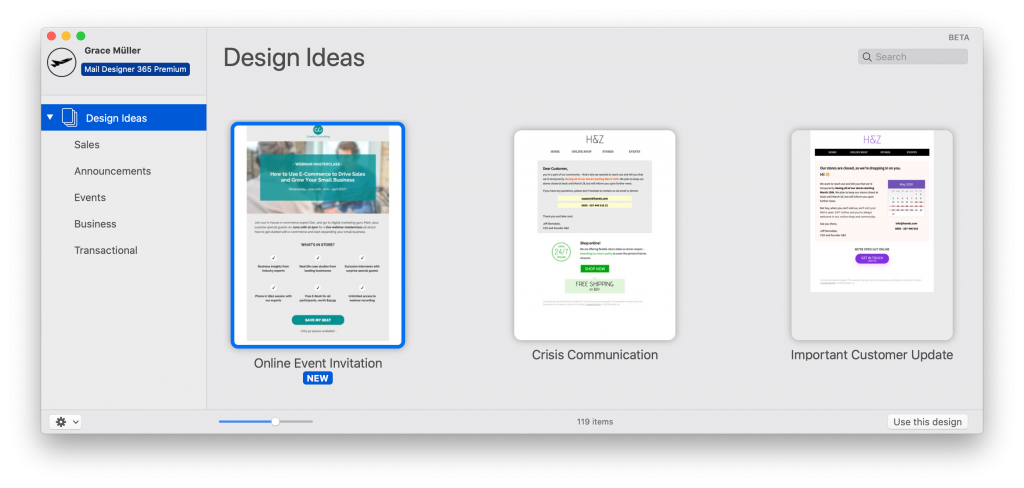 Read More
Read More
For B2B organizations, a well-executed webinar is often a great way to generate more leads. However, in order to ensure your webinar is a success, you first need to promote it effectively amongst your target audience. Coming up with a solid email marketing strategy for webinars is one way you can achieve this.
In this guide, you'll find useful tips on developing an effective email marketing strategy you can use to guarantee your webinar is a success.
Jump through this guide:
A webinar is an online meeting or seminar where participants are invited to discuss a range of topics within a certain field. Usually, the webinar is lead by an expert or group of experts in that field who will present information and answer any questions. The size of a webinar can range from just a handful of people to hundreds of attendees.
Especially in B2B, webinars are also often used as a way to introduce a product or service to potential new leads by means of a tutorial or case study.

Hosting a webinar gives you the chance to demonstrate your expertise in your field. It is a unique form of content marketing which, when executed correctly, helps establish you as an authority figure to your audience and creates a sense of trust. For example, the team at Really Good Emails upload weekly videos about email design which clearly establishes them as a leading authority in that field.
Here are some more great benefits of hosting a webinar:
Once you've taken the first steps in deciding you want to host a webinar, you now need to make sure it's a success. Here is our 3 step email marketing strategy for promoting your webinar.
In the weeks building up to your webinar, the focus is on promoting it to the right audience and ensuring you get as many sign ups as possible.
The first step in creating an email marketing strategy for your webinar is identifying your target audience. This will allow you to segment your email list accordingly, and choose the appropriate tone for your email.
Think about the content of your webinar and who will find it most relevant. This will become your target audience. For example, if your webinar is an introductory walkthrough of your product, you will most likely want to consider new sign ups or demo users as a target audience.
Once you've identified the segment of your email list you want to target, you can start designing the email invitation. We like to know what we're getting into, so the element of surprise is not desirable here.
In the initial announcement email, be sure to include a preview of the key topics your webinar will be covering. This will help get recipients hyped up for the event and also helps your recipients assess whether the webinar is relevant to them. Whatever the aim of your webinar is, you only want participants who are genuinely interested, as they are more likely to engage.
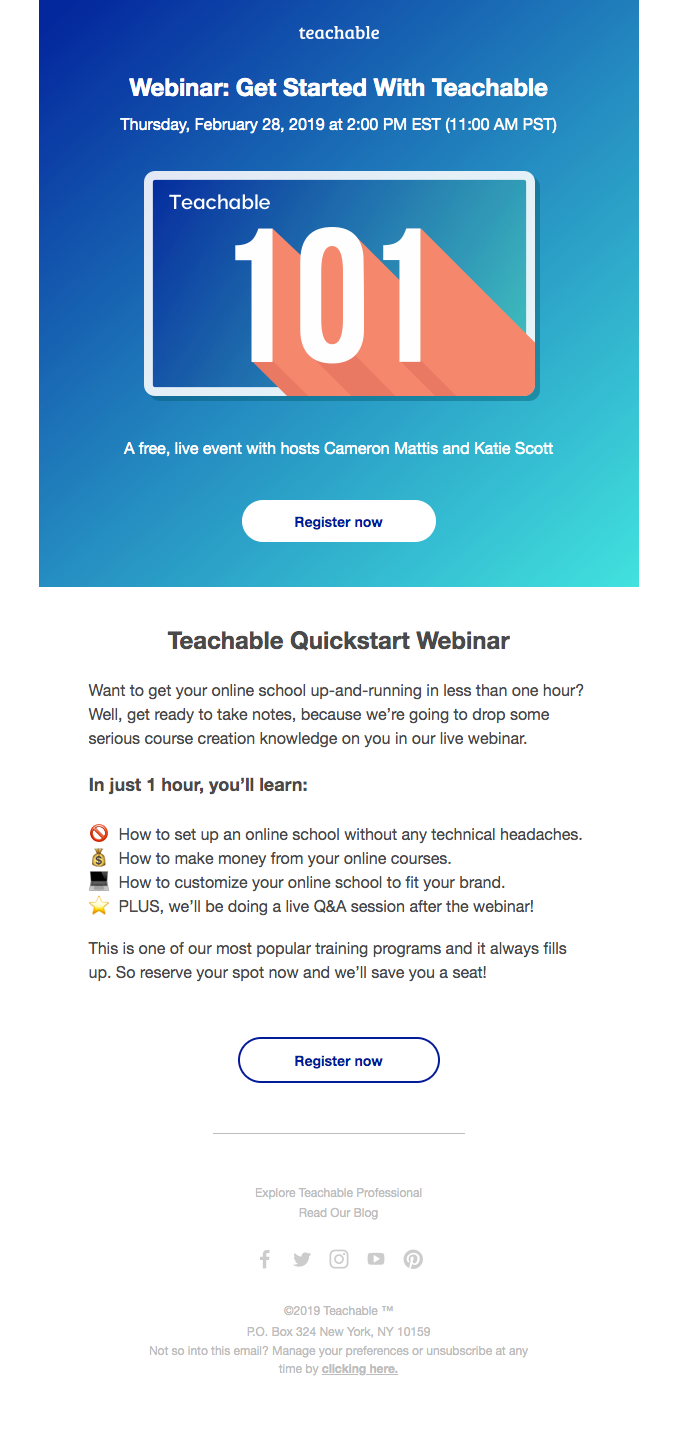
This email by Teachable makes sure those invited know exactly what is being covered in the webinar.
Helpful hint: Using your subject line to convey the main topic of your webinar is a great way to capture readers' attention from the first point of contact with the email.
The best way to encourage more sign ups is through a clear and effective CTA (call-to-action) button. If your recipient has read your email invite and still can't figure out how to register for the event, something has definitely gone wrong.
As a general rule of thumb, your CTA button should...
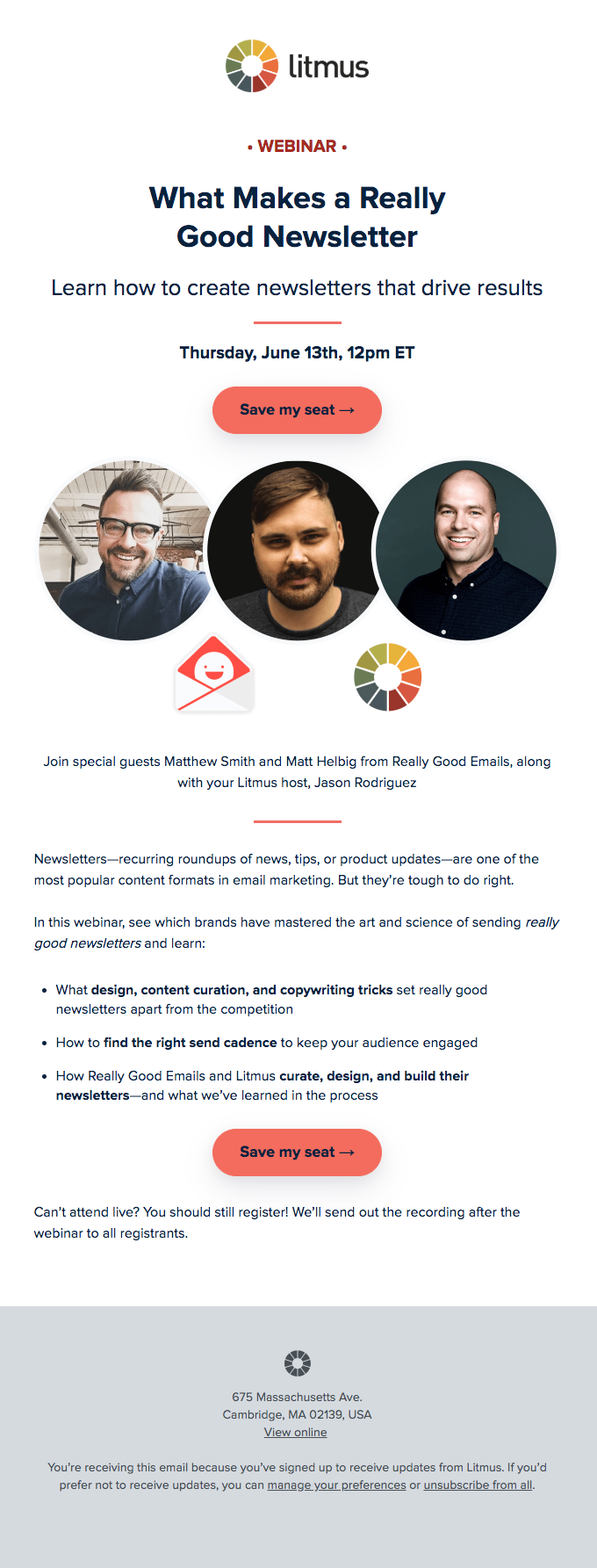
Not only do Litmus choose a striking color for their CTA button, the text is also short and snappy.
Be sure to include all of these characteristics in your email invitation to improve your chances of a high sign up rate.
Sending out the invitations to your webinar at the right time is key and bad timing can often lead to you missing out on a huge chunk of potential leads. If you send out an announcement last minute, many of your target audience will already have plans in place - especially if you are targeting busy business users. For this reason, it's important you give invitees plenty of notice for your webinar.
On the other hand, sending out an invitation too far in advance is also not recommended. This not only increases the chance of customers forgetting about your webinar, but could also deter others from signing up if they don't know how their schedule will look that far in the future.
We recommend you send out your first email a few weeks in advance to give attendees the chance to pencil you in to their calendar. Don't forget to also create a calendar event for the webinar and link to this in your email.
A few days before your webinar takes place, you need to make sure everything is in order. This involves reminder emails, last minute checks and providing key information.
Many of us have super busy schedules and it's natural for things to slip our minds. For this reason, it's important to make the experience as straightforward and accessible as possible. The last thing you want is for previously interested leads to not take part on the day because they forgot about the webinar, can't find the email invitation, or are missing relevant information. You need to be on the ball.
Take the time to send out a reminder email a day or so before the webinar to finalise all the important details participants need to know in order to be prepared. This includes key information such as:
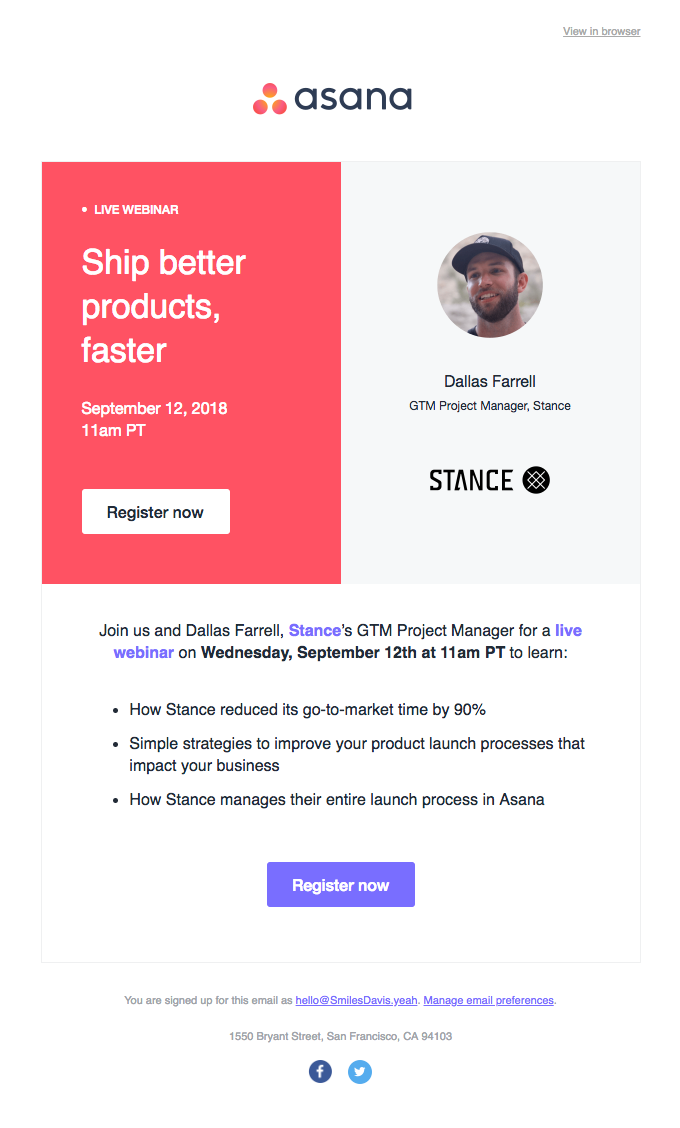
This email contains all the key info about the webinar which helps attendees get prepared.
With this information all at hand in one helpful email, your participants can look forward to the webinar whilst also feeling sufficiently prepared.
In some cases, your original invitation email may have gone unread, or the recipient may have forgotten to act. To ensure you don't miss out on any potential sign ups, it's also a good idea to chase up any lost leads you may have by sending a secondary invitation email.
Split your original list segment up into leads who signed up and leads who did not. Then, send those who aren't already signed up another email encouraging them to register for your webinar.
Try using time-sensitive language such as "last chance" or "only x hours left" to really emphasise the importance of signing up and generate a sense of urgency. You could also create a sense of urgency for your webinar by implying a shortage of spaces. This plays on the recipient's 'fear of missing out' and may be the final push they need to sign up.
Your webinar has taken place and everything went well. However, the after-event follow up is still a key part of any good email marketing strategy for webinars.
Now that your webinar is over, you need to make sure you meet your original goal. No matter how many took part, in the end, it's their actions that really count. Be prompt and send out a friendly follow up email shortly after the webinar has finished to target your leads while the content from your webinar is still fresh in their minds.
In this follow up email, be sure to thank participants for joining in with the webinar before leading on to your main call-to-action. For example, if this was a demo of your product, now is the chance to encourage customers to buy. If the webinar was purely informative, pointing new leads to sign up to your email newsletter or follow you on social media is also a proactive way of expanding your audience.
Finally, you should also include the chance for participants to provide you with feedback. This could be feedback to their general experience with your business, or targeted feedback about the webinar. Either way, you can use this to improve for next time!
Sending a reflection email to share a recording of the webinar has many great benefits. Firstly, participants who tuned in live on the day can watch back and go over any key points they might have missed or want to play back. They also have the chance to share the content with coworkers or other potential new leads; simultaneously promoting your business via word of mouth.
Secondly, an on demand video can also be a good way for those who signed up but did not tune in (i.e. due to illness, lack of time, unforeseen circumstances, etc.) to catch up on what they missed and experience your content in a different way.
Lastly, you could also send this video to other segments of your mailing list in future, to help promote your webinars in general. By giving new users a taster of the great content you produce, you increase the chances of more people signing up next time.
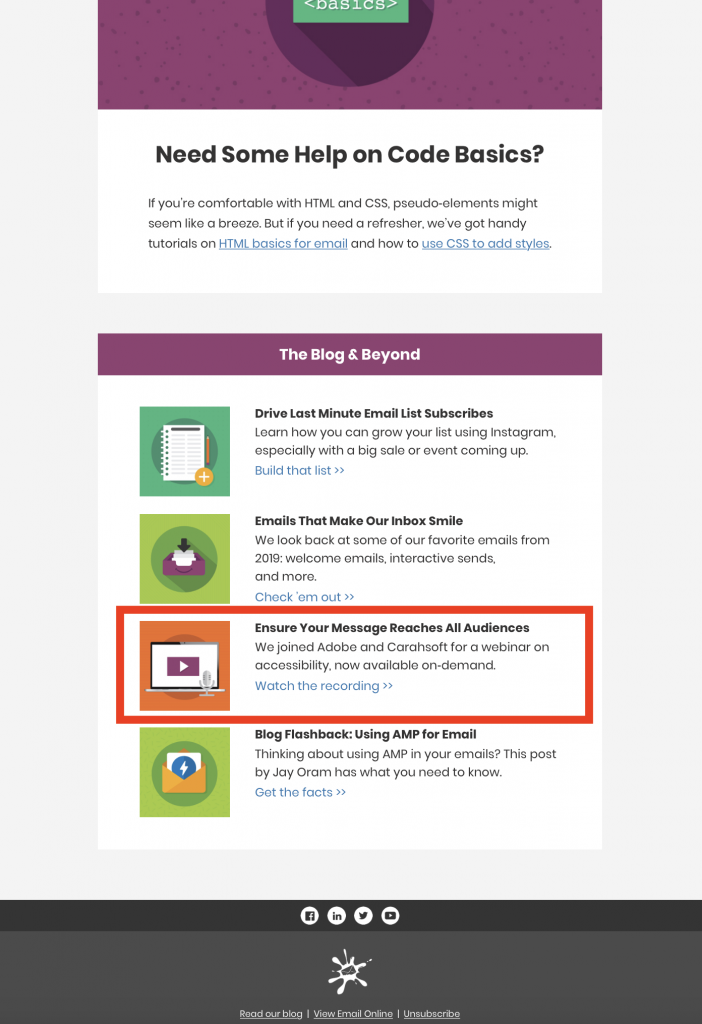
Email on Acid do a great job of promoting a past webinar by including a link at the end of this email newsletter.
Here are the 4 key emails you should be sending as part of the email marketing strategy for your webinar:
Mail Designer 365 has all the creative tools you need to design email templates to use as part of your webinar email marketing strategy. Here is an example of a webinar email invitation template now available in Mail Designer 365. Sign up free today to try it out for yourself!
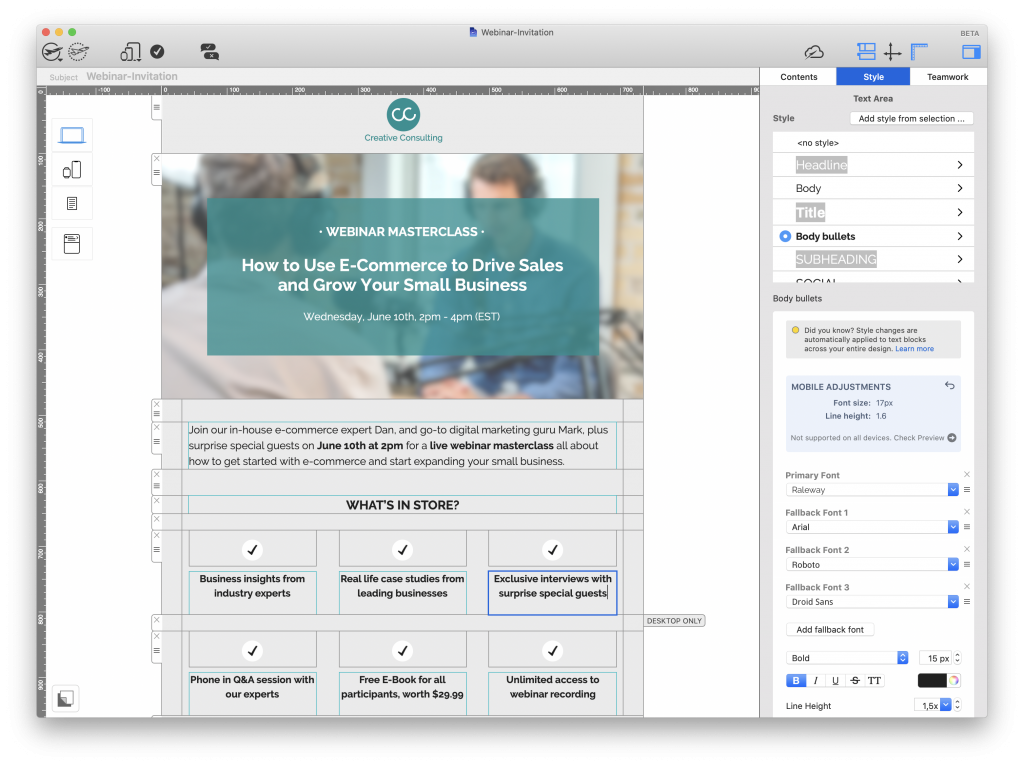
Webinar email invitation Design Idea - exclusively available in Mail Designer 365
You might also like:
How to Convert Keynote or PowerPoint Slides to Email - Our Quick Guide
Design Effective Onboarding Campaigns to Increase Customer Engagement
How to Get More Responses for Your Email Survey - 6 Easy Tips
Until next time,
Your Mail Designer 365 Team
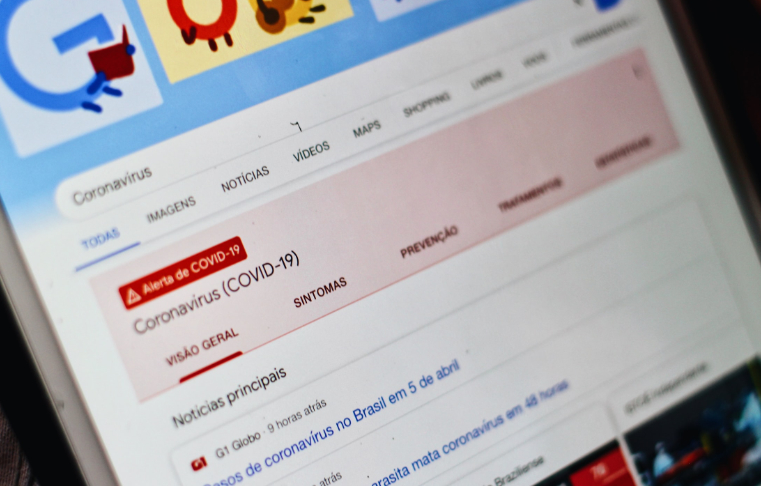
The ongoing coronavirus crisis makes the way you use internal emails to communicate with your team more important than ever. As well as providing colleagues with much needed support and guidance during these difficult times, it's also critical that you're able to keep spirits up and continue encouraging productive work.
As businesses all over the world are facing new working environments and constantly changing safety guidelines, your internal communication channels need to be effective. Here are some key pointers on sending internal emails to keep your team motivated and reassured during the coronavirus crisis.
Right now, the emphasis on health and safety is critical. Any business operating during these times will have safety guidelines in place to ensure the wellbeing of staff and customers alike.
Of course, as the situation changes, your safety guidelines will also need to be adjusted accordingly. Use your internal newsletter to let your staff know about the guidelines you have put in place and continue to reenforce these in every newsletter to emphasise their importance.
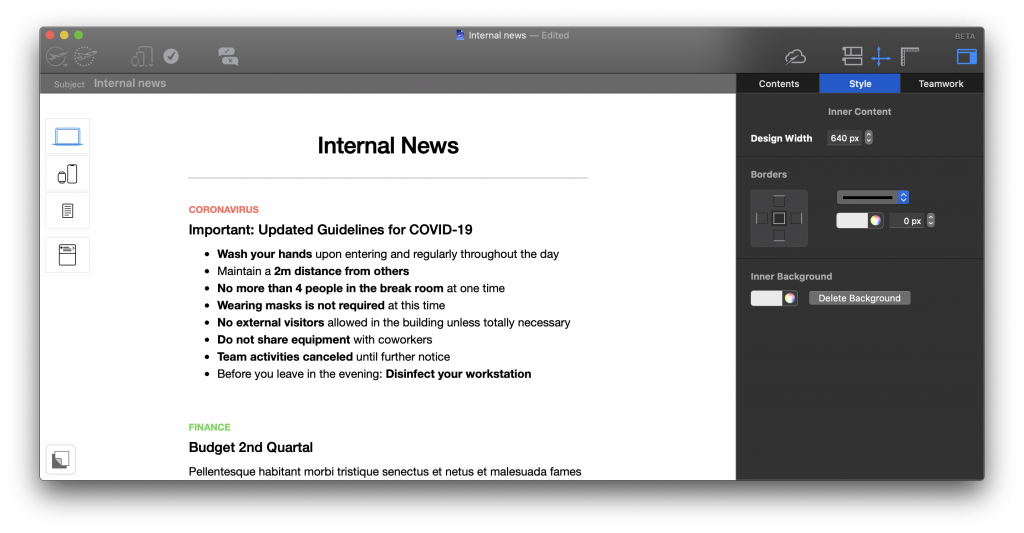
List and reenforce your business's key guidelines in each internal email newsletter.
If anything changes (e.g. mandatory face masks, new rules for lunch breaks, etc.), your internal newsletter should be the first place you communicate this. This helps prevent false information from spreading and keeps everyone on the same page.
When it comes to internal newsletters during the coronavirus crisis, consistency is key.
Compiling all of the most important information into a weekly or bi-monthly internal newsletter helps everyone stay up-to-date with the latest guidelines and shows your coworkers that you are committed to keeping up the channel of communication.
Sticking to a clear sending schedule also helps your staff know when to expect a newsletter and makes it less likely that important emails will go unread.
How your internal newsletter looks is just as important as what's inside it. If your newsletter layout is a mess, your colleagues will struggle to take in the information effectively and may not even finish reading.
As well as a healthy balance of text and images, you should also divide your email up into clear and concise sections with bold headlines. This helps anyone skim reading get to the most important information and also makes the whole thing much easier to read and process.
Tip: Lots of information to cover? Try using a different color for coronavirus updates. This will help coworkers in a rush to identify this information faster.
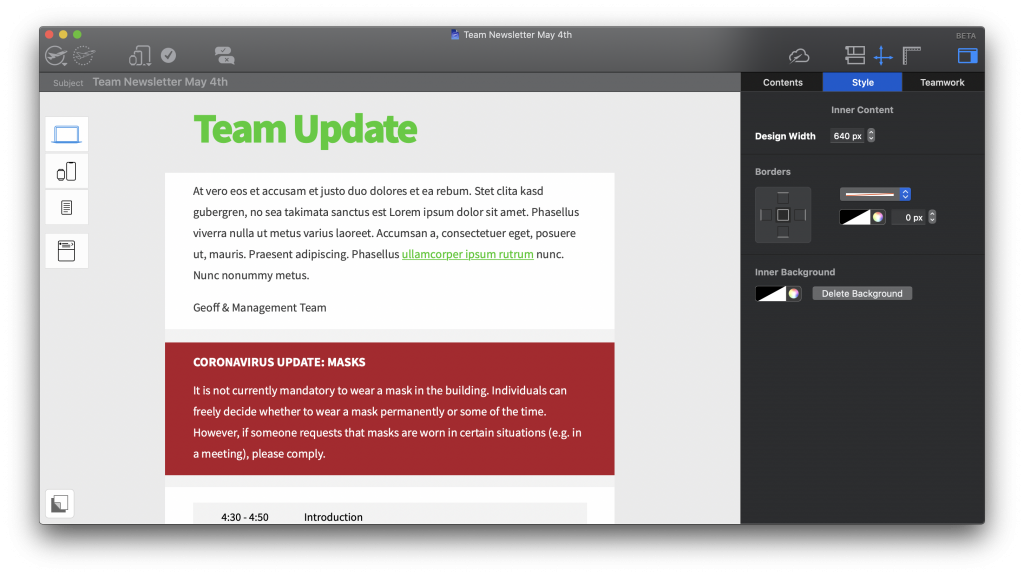
Using a different color (e.g. red) for coronavirus updates helps your team identify this information faster.
The situation is changing rapidly every day and most of us find ourselves frequently checking up on the latest coronavirus news. Whilst doing this, it's also human nature to question how the latest developments will affect us.
To avoid confusion and speculation amongst colleagues, use your internal newsletter to react to any news that you know will directly impact your business. Some current examples could include:

Inform your colleagues about mask regulations or other important developments which could impact them.
The faster you react to this type of news and put a statement together for staff, the more reassured they will feel.
It's not just external news you should be responding to, but also the general feeling within your team. This is a worrying time for everyone and your colleagues will no doubt have a large amount of questions and concerns which they may want to air.
Use your internal emails to grant your colleagues the chance to tell you how they are feeling in regards to the coronavirus. One great way of facilitating this is via an online survey platform such as Google Forms or Survey Monkey.
Creating an anonymous team survey helps you get a general idea of how your team is feeling so that you can address their issues or problems directly. Anonymity will also encourage colleagues to be more honest without worrying about what others may think.
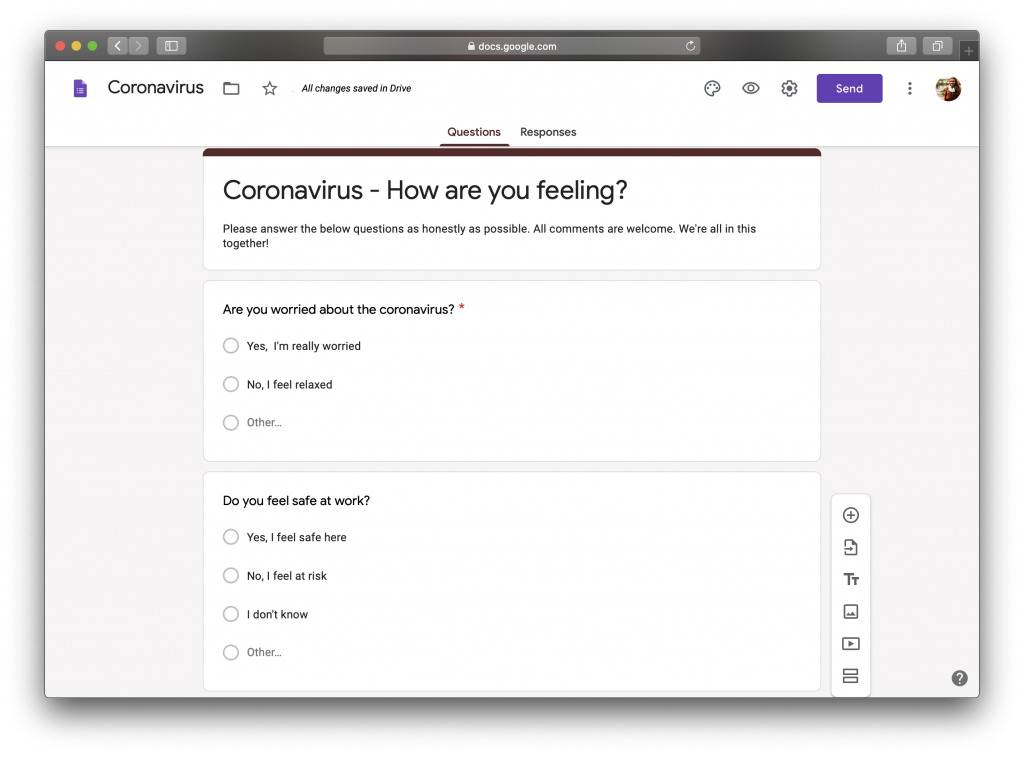
Create a short, anonymous feedback form to find out how your staff are feeling.
Tip: If possible, sharing the anonymous results of the survey in the next newsletter may also help reassure team members that they are not alone in their concerns.
Take advantage of your internal emails and use this communication channel as a way to also share useful resources with your team.
This could be anything from official government resources, to an inspiring blog post, or just handy life hacks to help them get through the crisis. Your team will be bound to appreciate this kind of information.
Most importantly, you also need to let your coworkers know that help is available if they need it. Make sure to point out any relevant support systems your company has in place should anyone be feeling affected by the situation.
Lastly, in addition to all the serious content surrounding the coronavirus, it is also a good idea for you to include some lighthearted, happier news in your internal emails.
Content such as funny cartoons and memes, GIFs, positive internal announcements (e.g. birthdays, engagements, new babies, etc.), tried & tested recipes, or just general feel-good news stories are all great additions to your internal newsletter that will help keep spirits up within the team.
Internal emails are an essential part of your business's internal communication channels - especially during difficult times. For more general tips on creating an internal newsletter, check out these resources:
How to Create an Interesting Company Newsletter that Your Employees Will Want to Read
Maintaining Your Internal Newsletters - Keep Co-Workers Engaged and Interested in Your Newsletter
Until next time,
Your Mail Designer 365 Team
With government restrictions now in place to slow the spread of the coronavirus, times are currently tough for flower stores everywhere. As a business owner, this means a change of strategy is definitely needed to help get you through.
Mail Designer 365 has all you need to keep your business going strong through the crisis. Below you will find all of our email marketing resources for florists to help get your small business online, plus a brand new Design Idea...

With Mother's Day just around the corner, we're sure your business is planning a campaign to help your customers show their appreciation to their moms on this special day. Our brand new Mother's Day Design Idea is the perfect addition to any Mother's Day email campaign...
Mail Designer 365 offers you a huge range of creative tools that you can use to make sure your email designs will always turn heads (and get customers clicking!)
In the new interactive Design Tips template, we've shared our team's all time favorite design tricks to help you get inspired for your next email design. On top of this, we've also added a set of brand new tutorial videos to show you how to recreate these amazing styles in Mail Designer 365...
Mail Designer 365 has all you need to keep your business going strong through the crisis. Below you will find all of our email marketing resources for cake stores and bakeries to help get your small business online, plus a brand new Design Idea...
